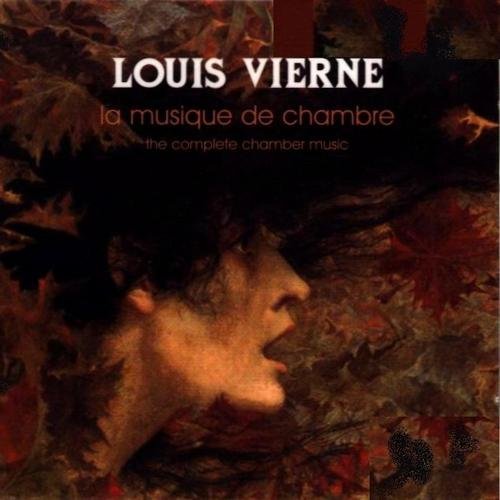Quatuor Phillips - Louis Vierne: Musique de Chambre Integrale (2005)

Artist: Quatuor Phillips
Title: Louis Vierne: Musique de Chambre Integrale
Year Of Release: 2005
Label: Timpani
Genre: Classical
Quality: FLAC (image+.cue,scans)
Total Time: 02:38:32
Total Size: 650 Mb
WebSite: Album Preview
Tracklist: Title: Louis Vierne: Musique de Chambre Integrale
Year Of Release: 2005
Label: Timpani
Genre: Classical
Quality: FLAC (image+.cue,scans)
Total Time: 02:38:32
Total Size: 650 Mb
WebSite: Album Preview
Louis Vierne (1870-1937)
CD 1:
Sonate pour violon et piano, op. 23 (1905-06)
01 I. Allegro (6:35)
02 II. Andante (11:19)
03 III. Intermezo (quasi vivace) (3:28)
04 IV. Largamente (allegro agitato) (12:58)
05 Rhapsodie pour harpe, op. 25 (1909) (10:49)
Quintette pour piano et cordes, op. 42 (1917-18)
06 I. Poco lento (moderato) (9:34)
07 II. Larghetto sostenuto (11:38)
08 III. Maestoso (allegro risoluto) (9:16)
Deux pieces pour alto et piano, op. 5 (1894)
09 I. Le Soir (4:00)
10 II. Legende (1:58)
CD 2:
Sonate pour violoncelle et piano, op. 27 (1910)
01 I. Poco lento (allegro moderato) (8:44)
02 II. Molto largamente (9:10)
03 III. Risoluto (allegro molto) (6:00)
Largo et Canzonetta pour hautbois et piano, op. 6 (1894)
04 I. Largo (3:52)
05 II. Canzonetta (2:28)
Soirs etrangers pour violoncelle et piano, op. 56 (1928)
06 1. Grenade (4:07)
07 2. Sur le Leman (5:48)
08 3. Venise (3:54)
09 4. Stepe canadien (9:20)
10 5. Poisson chinois (2:25)
Quatuor а cordes, op. 12 (1894)
11 I. Lento (allegro agitato) (5:43)
12 II. Intermezzo (leggiero non troppo vivo) (2:49)
13 III. Andante (quasi adagio) (5:52)
14 IV. Allegro vivace (6:33)
Performers:
Quatuor Phillips
Francois Kerdoncuff, piano
Olivier Gardon, piano
Alexis Galperine, violon
Yvan Chiffoleau, violoncelle
Christian Moreaux, hautbois
Odile Carracilly, alto
Pascale Zanlonghi, harpe
Louis Vierne est né à Poitiers en 1870. Atteint d'une cataracte congénitale, il entre à l'Institut national des jeunes aveugles, où César Franck (1822-1890) le remarque lors d'un examen de piano en 1884 et l'incite à suivre les cours du Conservatoire de Paris. Vierne entre dans la classe d'orgue de Franck en 1889 puis, après la mort de Franck, il devient l'élève puis l'assistant de Charles-Marie Widor (1844-1937). En 1900, un concours est organisé pour attribuer la place de titulaire des grandes orgues de Notre-Dame de Paris. Louis Vierne le remporte, et il restera à ce poste jusqu'à sa mort, survenue en 1937. Il a composé un grand nombre de pièces pour orgues, de la musique sacrée (Messes basse et solennelle...) mais aussi de la musique profane (six Symphonies pour orgue, quatre Suites de pièces de fantaisie pour orgue...), de la musique pour piano, de la musique de chambre, dont le Quatuor à cordes Op. 12 (1894), la Sonate pour violon et piano Op. 23 (1906), la Sonate pour piano et violoncelle OP. 27 (1910) et le Quintette pour piano et cordes Op. 42 (1917) interprétés ici, de la musique symphonique, dont une Symphonie pour grand orchestre et plusieurs Poèmes symphoniques, ainsi que des mélodies, principalement sur des poèmes de Baudelaire et surtout de Verlaine.
Why has a talented late-Romantic composer, with the passion and tragic sensibility of a Rachmaninov, come to be remembered almost exclusively for his weekend job at the organ of Notre-Dame? The fifth release in the Timpani label’s marvellous survey of Vierne’s music, these two entrancing discs are packed with treasures. The intense ardour of the sonatas for violin and cello, written for Ysaÿe and Casals respectively, should win many converts to Vierne’s cause. If the style here hovers between Franck, Elgar and Rachmaninov, there are signs of Debussy’s influence in the much later cello collection Soirs étrangers.
The youthful string quartet is remarkable in the composer’s output for its easy-going nature; a charming work, but not matching the profundity of later offerings, even with the impressive advocacy of the Quatuor Phillips. The minor works are little gems as well, especially the two viola pieces, but it is the Piano Quintet that makes this set indispensable. Written after the death of Vierne’s son, the raw emotions attest to the composer’s desire to ‘bury him in a roar of thunder and not in the plaintive bleating of a resigned, complacent sheep’. Emotion and technique combine to stunning effect, especially when allied, as in the other works, to first-rate performances and sound. Strongly recommended.
Why has a talented late-Romantic composer, with the passion and tragic sensibility of a Rachmaninov, come to be remembered almost exclusively for his weekend job at the organ of Notre-Dame? The fifth release in the Timpani label’s marvellous survey of Vierne’s music, these two entrancing discs are packed with treasures. The intense ardour of the sonatas for violin and cello, written for Ysaÿe and Casals respectively, should win many converts to Vierne’s cause. If the style here hovers between Franck, Elgar and Rachmaninov, there are signs of Debussy’s influence in the much later cello collection Soirs étrangers.
The youthful string quartet is remarkable in the composer’s output for its easy-going nature; a charming work, but not matching the profundity of later offerings, even with the impressive advocacy of the Quatuor Phillips. The minor works are little gems as well, especially the two viola pieces, but it is the Piano Quintet that makes this set indispensable. Written after the death of Vierne’s son, the raw emotions attest to the composer’s desire to ‘bury him in a roar of thunder and not in the plaintive bleating of a resigned, complacent sheep’. Emotion and technique combine to stunning effect, especially when allied, as in the other works, to first-rate performances and sound. Strongly recommended.





![The Mood Mosaic - Feelin' Funky! (2025) [Hi-Res] The Mood Mosaic - Feelin' Funky! (2025) [Hi-Res]](https://www.dibpic.com/uploads/posts/2025-12/1766822228_smv6og19mj83k_600.jpg)
![The Second Hand Orchestra - SNOW, This Is Christmas (2025) [Hi-Res] The Second Hand Orchestra - SNOW, This Is Christmas (2025) [Hi-Res]](https://img.israbox.com/img/2025-12/29/rduearbt1v1wv82iyir3kdf41.jpg)

